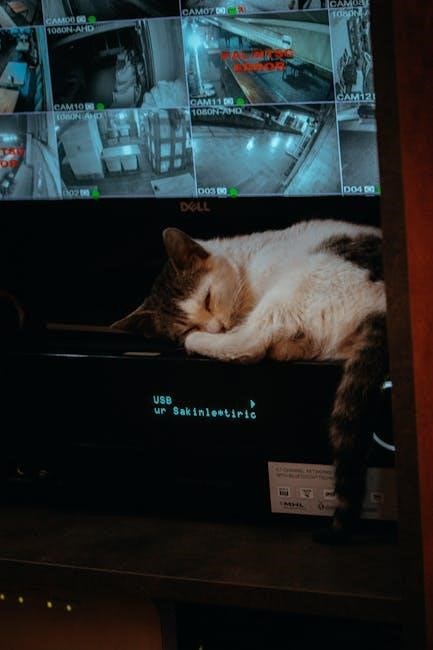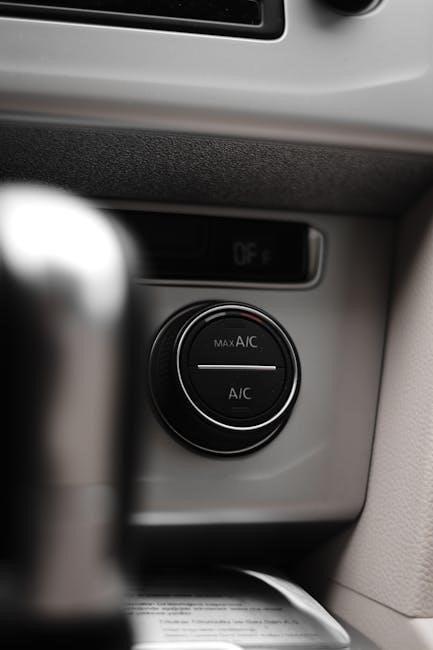The Caterpillar P5000 Throttle Control Switch is a critical component in forklift operations, ensuring precise engine control and operational efficiency. Its proper functioning is essential for smooth performance and safety, making it a focal point for regular maintenance and troubleshooting.
1.1 Overview of the Throttle Control Switch
The Caterpillar P5000 Throttle Control Switch is a vital component designed to regulate engine performance in forklift operations. It functions as an interface between the operator and the engine, translating input into precise throttle responses. The switch assembly includes a potentiometer, sensors, and a wiring harness, working together to ensure smooth acceleration and control. Its durability and reliability are crucial for maintaining operational efficiency, making it a key focus for troubleshooting and maintenance procedures. Proper functionality ensures safe and effective forklift performance, while any malfunction can lead to operational disruptions.
1.2 Importance of the Throttle Control Switch in Forklift Operations
The throttle control switch is indispensable for ensuring precise control and safety in forklift operations. It directly impacts the operator’s ability to regulate speed and responsiveness, making it a critical component for preventing accidents and maintaining efficiency. Any malfunction can lead to unexpected acceleration or engine issues, posing significant safety risks. Regular maintenance and troubleshooting of the switch are essential to uphold operational reliability and prevent costly downtime. Its proper functioning ensures smooth workflow and operator confidence, highlighting its pivotal role in industrial environments.
Understanding the Anatomy of the Throttle Control Switch
The Caterpillar P5000 Throttle Control Switch comprises a potentiometer, sensors, and wiring harness, essential for translating operator input into precise engine responses.
2.1 Components of the Throttle Switch Assembly
The throttle switch assembly of the Caterpillar P5000 includes a potentiometer for measuring throttle position, sensors for detecting operational parameters, and a wiring harness for secure electrical connections. These components work together to ensure accurate signal transmission to the engine control module, enabling smooth and responsive operation. Proper maintenance and inspection of these parts are crucial for preventing faults and ensuring optimal performance.
2.2 Role of the Potentiometer and Sensors
The potentiometer in the Caterpillar P5000 Throttle Control Switch measures the throttle valve’s position, converting it into an electrical signal for the engine control module (ECM). Sensors monitor operational parameters such as throttle position, temperature, and engine speed, ensuring accurate data transmission. Together, they enable precise fuel delivery, smooth acceleration, and efficient engine performance. Any malfunction in these components can lead to throttle response issues, emphasizing the need for regular inspection and calibration to maintain optimal functionality and prevent operational disruptions.
2.3 Wiring Harness and Electrical Connections
The wiring harness in the Caterpillar P5000 Throttle Control Switch connects the potentiometer, sensors, and control modules, ensuring seamless communication. Electrical connections must be clean and secure to prevent signal loss or interference. Corrosion, wear, or loose connections can disrupt throttle functionality, leading to erratic behavior. Regular inspection and tightening of these connections are crucial for maintaining reliable operation. Any damage to the wiring harness should be addressed promptly to avoid costly repairs and ensure the system operates efficiently and safely. Proper maintenance of these components is vital for optimal performance.
Common Issues with the Throttle Control Switch
Common issues include unexpected acceleration, lack of response, or engine starting problems. These symptoms often indicate faults in the throttle switch, sensors, or electrical connections, requiring prompt attention.
3.1 Symptoms of a Faulty Throttle Control Switch
Common symptoms of a faulty throttle control switch include unexpected acceleration, delayed or no response when operating the throttle, and difficulty starting the engine. Additionally, irregular idling, such as fluctuating RPMs or stalling at low speeds, can indicate a problem. These issues often stem from faulty sensors, corrosion in electrical connections, or a malfunctioning potentiometer. Addressing these symptoms promptly is crucial to maintain operational safety and efficiency, preventing more severe damage or downtime. Regular inspection of the switch and its components can help identify these problems early on.
3.2 Unexpected Acceleration or Lack of Response
Unexpected acceleration or a lack of response from the throttle control switch can disrupt normal forklift operations, posing safety risks. This issue may arise due to faulty sensors or electrical connections within the switch assembly. Corrosion or wear on the potentiometer can also cause erratic throttle behavior. Operators may experience sudden surges in engine RPM or complete unresponsiveness when attempting to adjust speed. Such malfunctions require immediate attention to prevent accidents and ensure operational safety. Regular inspection and maintenance of the throttle control switch are essential to mitigate these risks and maintain consistent performance.

3.3 Engine Starting Problems Related to the Throttle Switch
Engine starting issues linked to the throttle control switch can stem from faulty sensors or improper calibration. If the throttle position sensor fails to accurately detect the valve’s position, the engine may not start or may stall frequently. Additionally, corroded or loose electrical connections within the switch assembly can disrupt communication between the throttle and the engine control module. Performing the throttle valve closed position learn procedure may resolve these issues. Regular inspection and cleaning of connections, along with sensor testing, are crucial to ensure reliable engine operation and prevent persistent starting problems.

Basic Troubleshooting Steps
Start with key switch operations, counting seconds for initial diagnosis, and completing the learn process for throttle valve position to ensure proper functionality and address issues effectively.
4.1 Turning the Key Switch ON and OFF for Initial Diagnosis
Begin by turning the key switch to the ON position and counting out 2 seconds. This initializes the system. Next, turn the key switch OFF and wait 10 to 12 seconds. Repeat this process to check for consistent responses. Observe if the throttle control switch engages properly or if any irregular behavior occurs. If issues persist, proceed to more advanced troubleshooting steps, such as testing the throttle position sensor with a multimeter or checking electrical connections for cleanliness and tightness. This initial diagnosis helps identify basic faults quickly and effectively.
4.2 Counting Seconds for Proper Switch Functionality
Counting seconds is a crucial step in diagnosing the throttle control switch. After turning the key switch ON, count 2 seconds to allow the system to initialize. Then, turn it OFF and wait 10-12 seconds, observing the switch’s response. This timing helps identify if the switch is functioning correctly or if there are delays or malfunctions. Proper timing ensures accurate diagnostics, helping technicians pinpoint issues like faulty sensors or connections. This methodical approach is essential for effective troubleshooting and maintaining the switch’s reliability and performance.
4.3 Completing the Learn Process for Throttle Valve Position
The learn process for the throttle valve position ensures the system accurately calibrates to the switch’s input. Start by turning the key switch ON and counting 2 seconds. Then, turn it OFF and wait 10-12 seconds. Turn the key ON again and count 2 seconds. This sequence allows the system to memorize the throttle’s closed position, ensuring precise control. Proper completion of this process is vital for smooth operation and preventing issues like unexpected acceleration or lack of response. Once done, the system will function optimally, enhancing both performance and safety.

Advanced Troubleshooting Techniques
Advanced troubleshooting involves testing the throttle position sensor, inspecting wiring, and verifying electrical connections. Use diagnostic tools to identify faults and ensure proper system calibration for optimal performance.
5.1 Testing the Throttle Position Sensor with a Multimeter
Testing the throttle position sensor with a multimeter is essential for diagnosing electrical issues. Set the multimeter to DC voltage mode and measure the voltage across the sensor terminals. Ensure the throttle is in the closed position and observe the voltage reading. Gradually move the throttle to the full-open position and check for a smooth, linear voltage increase. If the reading is inconsistent or incorrect, the sensor may be faulty. Clean or replace the sensor as needed and verify proper electrical connections before retesting. This step ensures accurate throttle control and prevents operational discrepancies.

5.2 Checking Electrical Connections and Cleanliness
Inspecting electrical connections and ensuring cleanliness is vital for proper throttle control switch functionality. Start by cleaning the connectors with a soft brush or contact cleaner to remove dirt and corrosion. Visually inspect all wiring and connections for signs of wear or damage. Tighten any loose connections and replace corroded or frayed wires. Use a multimeter to verify continuity and resistance in the circuit. Cleanliness and secure connections ensure proper communication between the throttle sensor, controllers, and the engine, preventing malfunctions and improving overall system reliability and performance.
5.3 Ensuring Proper Fastening of the Sensor
Properly securing the throttle position sensor is crucial for accurate signal transmission. Begin by tightening all mounting screws to the manufacturer’s specified torque. Ensure the sensor is aligned correctly with the throttle valve to maintain precise feedback. Check for any play or movement in the sensor’s position, as this can lead to inconsistent performance. If necessary, use lock washers or threadlocker to prevent loosening over time. A securely fastened sensor guarantees reliable data transmission to the engine control module, ensuring smooth throttle response and preventing operational issues.

The Role of Controllers in Throttle Control
The Vehicle Control Module (VCM) and Engine Control Module (ECM) play pivotal roles in monitoring throttle inputs, processing sensor data, and ensuring precise engine performance and operational efficiency.
6.1 Vehicle Control Module (VCM) and Engine Control Module (ECM)
The Vehicle Control Module (VCM) and Engine Control Module (ECM) are central to the Caterpillar P5000’s throttle control system. These modules process data from the throttle position sensor and other inputs to optimize engine performance. The VCM manages overall vehicle functions, while the ECM focuses on engine operations, ensuring precise fuel delivery and airflow. Together, they monitor inputs and outputs, enabling advanced diagnostics and troubleshooting. Service tools can interface with these modules to retrieve error codes and perform adjustments, making them indispensable for maintaining efficient and safe throttle control.
6.2 Monitoring Inputs and Outputs Using Service Tool Functions
Service tools enable real-time monitoring of inputs and outputs for the Caterpillar P5000’s throttle control system. Technicians can access live data, such as throttle position, sensor voltages, and output commands, to diagnose issues. These tools allow for precise identification of faulty components, like sensors or wiring, by analyzing data flow. Error codes can also be retrieved to pinpoint specific problems. Monitoring these interactions ensures accurate troubleshooting, helping to restore optimal performance and prevent operational disruptions. This functionality is crucial for maintaining the reliability and efficiency of the throttle control switch and related systems.
6.3 Troubleshooting Error Codes Related to Throttle Control
Troubleshooting error codes for the Caterpillar P5000 Throttle Control Switch involves identifying specific issues through diagnostic tools. Error codes provide insights into problems like faulty sensors, wiring issues, or miscommunication between components. By analyzing these codes, technicians can isolate the root cause, such as a malfunctioning throttle position sensor or corrupted signals. Using service tools, professionals can clear codes after repairs and verify system functionality. Proper code interpretation ensures efficient resolution of throttle-related errors, minimizing downtime and ensuring safe forklift operation. Always refer to the service manual for code definitions and corrective actions.

Throttle Valve Closed Position Learn Procedure
The throttle valve closed position learn procedure involves key switch operations and counting specific time intervals to ensure proper throttle calibration and system synchronization.
7.1 Step-by-Step Instructions for Throttle Valve Learning
To perform the throttle valve closed position learn procedure, start by turning the key switch to the ON position and counting out 2 seconds. Next, turn the key switch OFF and wait for 10 to 12 seconds. Afterward, turn the key switch back ON and count out another 2 seconds. This completes the learning process, ensuring the throttle valve is properly calibrated. Accurate timing and sequence are crucial for successful synchronization. Always refer to the service manual for detailed instructions and safety precautions during this procedure to avoid any potential issues with the throttle control system.
7.2 Key Switch Operations During the Learning Process
During the throttle valve learning process, precise key switch operations are essential. Start by turning the key switch to the ON position and holding it for exactly 2 seconds. This initializes the learning sequence. Next, turn the key switch OFF and wait for 10 to 12 seconds to allow the system to reset and synchronize. Finally, turn the key switch back ON and hold it for another 2 seconds to complete the calibration. Proper timing and sequence ensure accurate throttle valve positioning and optimal engine performance. Follow these steps carefully to avoid errors during the learning process.
7.3 Completing the Learning Process Successfully
To successfully complete the learning process, ensure all key switch operations are performed accurately. After turning the key switch ON and OFF as specified, the system will confirm the learning process with a distinct indicator, such as a dashboard light or audible signal. Once completed, the throttle valve will be properly calibrated, ensuring precise engine response and performance. Proper completion of this process is critical for maintaining operational efficiency and safety. Always adhere to the recommended sequence and timing to avoid errors and ensure optimal results from the learning procedure.

Maintenance and Replacement Procedures
Regular maintenance involves cleaning electrical connections and inspecting components for wear. Replace faulty parts promptly to ensure optimal performance. Post-replacement testing confirms proper functionality and reliability.
8.1 Cleaning and Tightening Electrical Connections
Cleaning and tightening electrical connections are crucial for maintaining the throttle control switch’s efficiency. Use a soft brush or compressed air to remove dirt and corrosion. Ensure all terminals are secure and free from oxidation. Apply a thin layer of dielectric grease to protect against future corrosion. Avoid over-tightening, which could damage the connectors. Regular inspection and maintenance prevent intermittent issues and ensure reliable signal transmission between components. This step is essential for troubleshooting and maintaining optimal functionality of the Caterpillar P5000 system.
8.2 Replacing the Throttle Control Switch Assembly
Replacing the throttle control switch assembly is necessary when cleaning or troubleshooting fails to resolve issues. Begin by disconnecting the wiring harness from the old switch, ensuring no damage to the connectors. Remove the mounting screws and gently pull the assembly out. Install the new switch by aligning it properly and securing it with the provided hardware. Reconnect the wiring harness, making sure all connections are snug and correct. Finally, test the system to confirm proper functionality and address any remaining issues. Proper installation ensures reliable performance and prevents future malfunctions.

8.3 Post-Replacement Testing and Verification
After replacing the throttle control switch, thorough testing is essential to ensure proper functionality. Start by turning the key switch ON and OFF to verify the system resets correctly. Test the throttle response by gradually increasing and decreasing speed, checking for smooth operation. Ensure the engine starts without issues and that all electrical connections are secure. Use diagnostic tools to confirm no error codes persist. Complete a full operational test under various loads to validate performance. Proper verification ensures the forklift operates safely and efficiently, confirming the replacement was successful and reliable.

Service Manual and Repair Resources
The CAT P5000 service manual provides detailed repair guides, step-by-step instructions, and exploded-view illustrations. It ensures accurate troubleshooting and maintenance, with clear images for precise repairs and safety adherence.
9.1 CAT P5000 Service and Repair Manual Overview
The CAT P5000 Service and Repair Manual offers a comprehensive guide for maintaining and repairing the forklift. It includes detailed troubleshooting procedures, step-by-step repair instructions, and exploded-view diagrams to facilitate accurate diagnoses and fixes. The manual covers essential systems, including the throttle control switch, providing specific guidance for electrical and mechanical components. By adhering to the manual’s instructions, technicians can ensure optimal performance, safety, and longevity of the equipment. Regular reference to this manual is crucial for preventing and addressing issues efficiently.
9.2 Step-by-Step Instructions and Illustrations
The CAT P5000 Service and Repair Manual provides clear, step-by-step instructions for troubleshooting and repairing the throttle control switch and other components. Detailed illustrations, including exploded-view diagrams, help technicians visualize complex assemblies and understand proper disassembly and reassembly procedures. These visuals are particularly useful for identifying and accessing hard-to-reach components, such as the throttle control switch and its associated wiring. By following the manual’s guidance, technicians can efficiently diagnose and resolve issues, ensuring accurate and effective repairs. The combination of textual instructions and visual aids makes the manual an invaluable resource for maintaining the forklift’s performance and longevity.
9.3 Importance of Following Proper Safety Procedures
Adhering to proper safety procedures when servicing the Caterpillar P5000 Throttle Control Switch is crucial to prevent accidents and ensure effective repairs. Always disconnect the battery and wear protective gear before starting work. Following the service manual’s guidelines helps avoid potential hazards, such as electrical shocks or mechanical failures. Proper safety practices also ensure compliance with manufacturer recommendations, maintaining the integrity of the forklift’s systems. By prioritizing safety, technicians can perform repairs confidently and efficiently, minimizing risks to themselves and the equipment.
10.1 Summary of Key Troubleshooting Steps
Troubleshooting the Caterpillar P5000 Throttle Control Switch involves several key steps. First, perform basic checks like turning the key switch on and off, counting seconds, and completing the learn process; Advanced techniques include testing the throttle position sensor with a multimeter, checking electrical connections, and ensuring sensors are securely fastened. Regular maintenance, such as cleaning and tightening connections, is crucial. Replacing the switch assembly and post-replacement testing are also essential. Always refer to the service manual for detailed instructions and safety procedures to ensure effective troubleshooting and maintenance.
10.2 Final Tips for Maintaining Throttle Control Switch Efficiency
Regular maintenance is key to ensuring the Caterpillar P5000 Throttle Control Switch operates efficiently. Always clean and tighten electrical connections to prevent corrosion and ensure proper conductivity. Test the throttle position sensor with a multimeter to verify accuracy and replace it if necessary. Ensure the sensor is securely fastened to avoid loose connections. Follow the service manual for step-by-step instructions and safety guidelines. By adhering to these tips, you can extend the lifespan of the throttle control switch, maintain optimal performance, and minimize the risk of unexpected operational issues.
